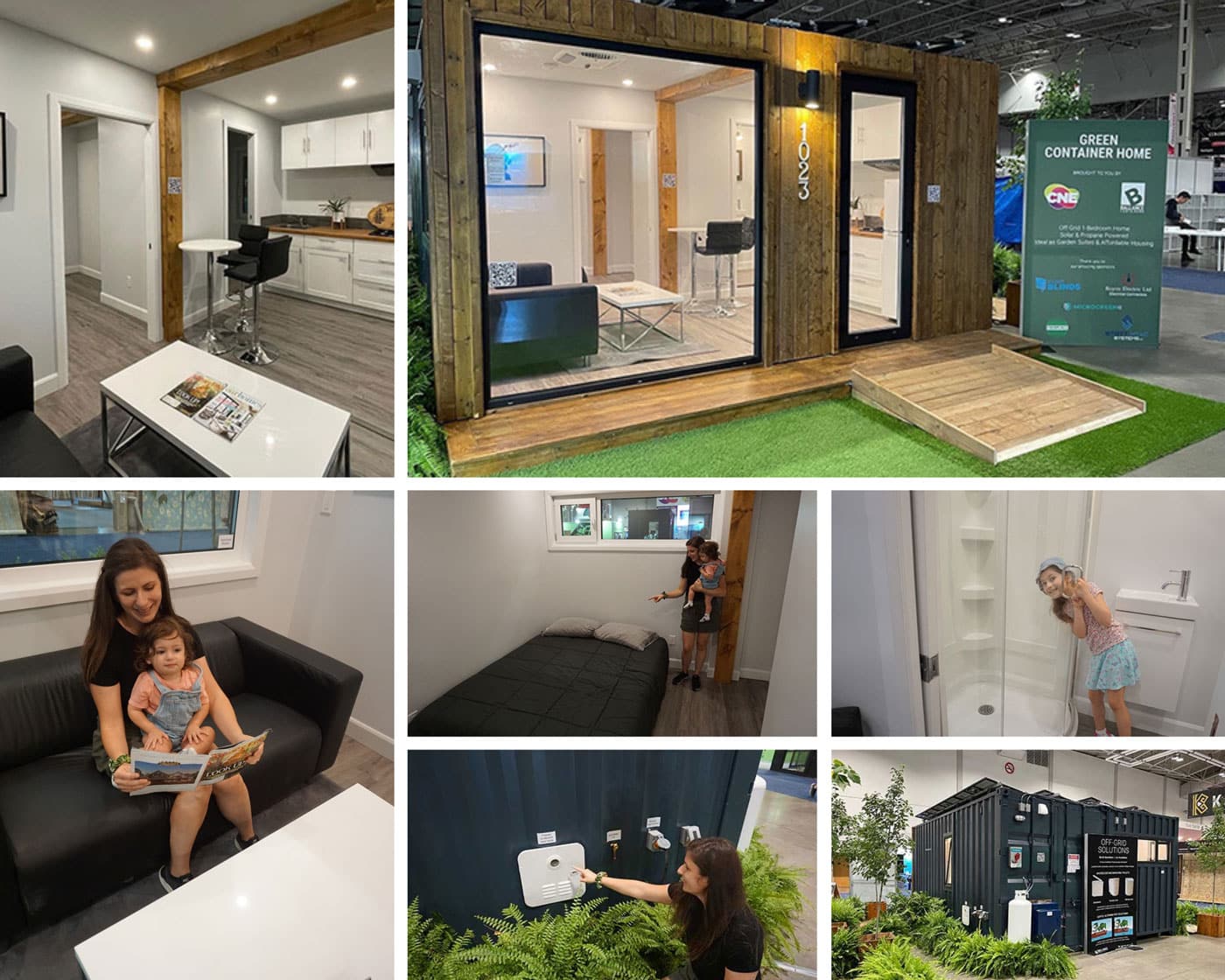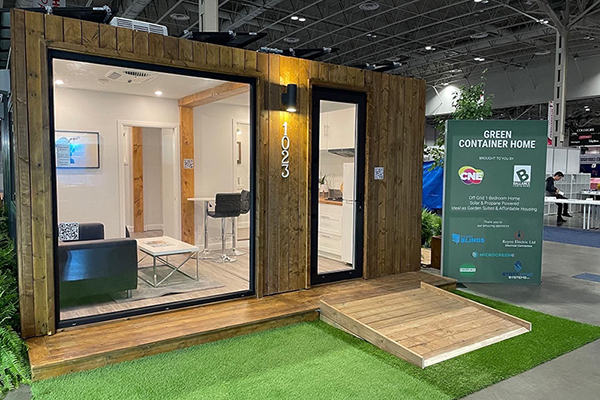- The sustainable, affordable, and swiftly deployable structure is an off-grid, solar and propane-powered 320-sq ft. unit with an incineration water treatment system.
- The structure features a spacious bedroom, open concept living area, galley kitchen and a full washroom.
- In line with Toronto’s commitment to expanding housing options in the city through the laneway and garden suite initiatives, container units like these could be a viable solution to the GTA’s housing supply crises.
After a two-year pandemic hiatus, the Canadian National Exhibition (CNE) returned better than ever. Flocks of crowds visited, ready and eager to enjoy a quintessential end-of-summer activity.
While at the event with my family, my daughter spotted the Green Container Home first, “Mommy, can we go in there?” she asked, pointing at a modular structure with wooden accents and large, inviting windows.
The first thing I noticed was the solar panels on the structure, though barely visible from the ground, and I was immediately excited to learn more. In line to enter, people around us were already considering it as an accessible solution to country living; “Maybe we can afford a cottage after all” one of them commented. Another was thinking through its investment potential and said “Plop a few of these down, and you’re set. We could market them as glamping.”
This got me thinking that size-wise, it’s a perfect way to swiftly get more sustainable residences in the city, in line with Toronto’s laneway and garden suite initiatives.
Going up the ramp, I imagined the deck could adorn lush planters. The entranceway is nicely lit, with no fumbling in the dark to open your cabin in the woods. An open concept layout greets you with a galley kitchen, dining area and living room.
Floor-to-ceiling windows in the main area ensure the unit feels bright and airy. The kitchen boasts more storage space than many new-build condos in Toronto and energy-efficient appliances, including a dishwasher and propane powered stove-top.
The bedroom is spacious, 10X10, furnished with a double bed, with ceilings high enough to accommodate a bunk bed. There’s even room for a built-in closet or a dresser and bookcase.
I was curious about the bathroom, wondering if it would require a septic tank. However, I was pleasantly surprised to learn that the unit is entirely off-grid, has a waste-water incineration system, and the bathroom also includes a shower!
A big upgrade compared to many cabin and glamping yurt style rentals on the market.

Image collage of the Green Container Home that was displayed at the 2022 CNE. (Sofia Martimianakis)
While living in one of these container homes, taking the little ones into the woods would be an option year-round. Having a spacious refuge from bugs and rainy weather when you have children in tow makes a big difference, and this would feel like staying in a resort suite with stunning views.
What was clear from checking out this structure is that guests were quickly able to see how this style of sustainable, modular housing could impact their lives.
Whether a mini-home, office or gym, an in-law suite, or a cottage alternative, the possibilities are bountiful for residents and investors.
I imagined future displays having an accompanying audio tour playing as guests toured the suite, drawing their attention to some of the unit’s innovative features.
Something like:
Welcome to the Green Container Home, designed by Balance Containers in partnership with Micro Green Solar.
The 320-sq ft. unit is completely off-grid, powered by solar and propane, featuring heating and air conditioning and an EcoJohn incineration water treatment system.
With a spacious bedroom, open concept living area, galley kitchen and full washroom, the GS-320 is fully customizable to your needs.
Further upgrades are available such as built-in cabinets and a covered porch alcove and deck.
Build anywhere.
Live anywhere.
Speaking with Eric Ballance, President of Ballance Containers, one of the appeals of units with solar panels depends on the location, the upgrade to panels could cost the same as connecting the unit to the grid.
He said that going with panels means bypassing the red tape and getting into your unit much faster. Also, since the unit doesn’t require a septic tank connection, it’s much easier to put in than a typical garden suite, which requires trenching to connect with the main building.
It could be installed anywhere; he said, “In cottage country, on a rockface even, where they wouldn’t be able to put in septic.” The GS-320 is one of the company’s smaller units, “We like to consider them like adult Lego; they can be fully customized and built to any size.”
With the City of Toronto adopting the Affordable Laneway Suites Program and the Garden Suites Plan, the focus has shifted to expanding housing options in the city with creative and affordable solutions.
In addition to this particular unit’s efficiency and sustainability, Eric explains, “For Developers, they could set up temporary small housing communities on vacant land that otherwise won’t be occupied for 5-10 years. These units could be dropped in for a housing solution and then moved in the future. We’ve got various developers petitioning Government officials about municipal land not currently in use. This could be an interim housing solution.”
In Vancouver, over the last three years, more than 650 temporary modular supportive homes have been created, providing immediate relief to hundreds of people without a home.
The Reiderman Residence is a temporary modular housing community supporting homeless and at-risk populations with 78 pet-friendly homes, a community kitchen, and training and employment opportunities for residents. Similarly, Margaret Mitchel Place is a 53-studio home modular building with a community garden and peer employment programs designed to provide opportunities for residents to join the community.
The hope is by increasing awareness of the benefits of modular housing solutions through exhibits like the Green Container Home at the CNE, units like the GS-320 can be considered a viable solution to the housing supply crises in the Greater Toronto Area. The unit will be back on display at the Ballance Container Showroom in Oakville, ON and will also travel to other Canadian fairs over the next few years.
Off-grid living never looked so good!













Comments